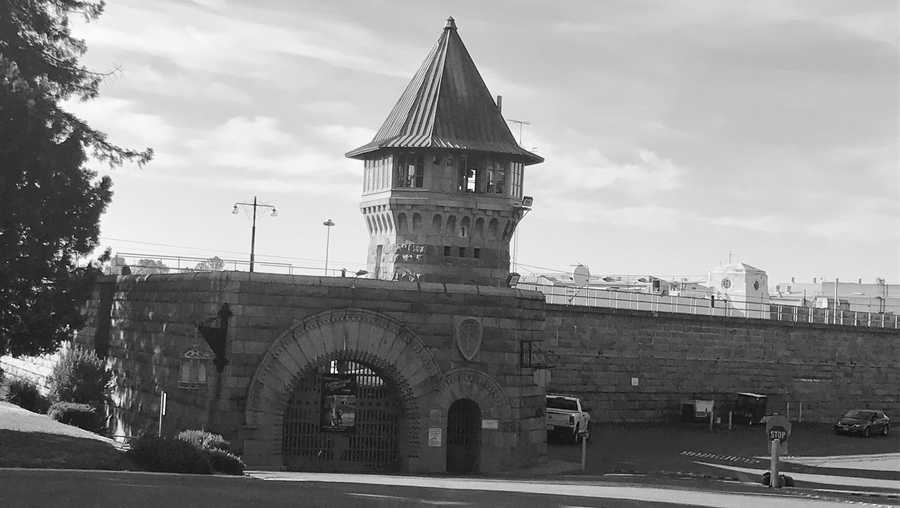Embark on a captivating visual journey through Folsom State Prison, California’s notorious penitentiary. These striking photographs reach beyond the imposing walls, revealing the human stories, architectural transformations, and cultural impact that have shaped this infamous institution. Prepare to witness the stark realities, resilience, and enduring legacy of Folsom State Prison as we explore its past and present through powerful imagery.
Life Inside: Folsom Prison Photos Reveal the Truth
Ever heard of Folsom Prison? You know, the one Johnny Cash sang about? Well, Folsom State Prison photos take us beyond the catchy tunes and into the real deal, offering a sobering glimpse into life behind bars.
These images showcase the stark realities of prison life – the massive walls, the cramped cells, and the daily routines of the incarcerated. Forget the romanticized notions often portrayed in movies and songs; these photos provide a raw and unfiltered look at the challenges and complexities of the prison system.
More Than Inmates: The Faces of Folsom
Look closely at the faces in these Folsom State Prison photos. These aren’t just numbers; they’re individuals with stories. You’ll see men who’ve spent years, even decades, within those walls, prompting reflection on their journeys and struggles. These images serve as a powerful reminder that even in prison, humanity persists.
A Journey Through Time: Folsom’s Evolving Legacy
Folsom State Prison photos also provide a fascinating historical perspective. They document the prison’s evolution from its early days as a super-max facility to the ongoing efforts at reform. This visual timeline offers insights into the changing approaches to incarceration and societal views on punishment.
Glimmers of Hope: Programs for Redemption
Amidst the stark realities, some Folsom State Prison photos highlight programs aimed at rehabilitation. You’ll see inmates engaged in learning new skills, receiving counseling, and working towards a fresh start. These images offer a glimmer of hope, suggesting that even in a place like Folsom, the possibility of change and redemption exists.
Unveiling the Notoriety of Folsom Prison: A Deep Dive into its Fame
Folsom Prison isn’t just another correctional facility; it occupies a unique space in American history and pop culture. But what exactly catapulted it to such notoriety? Let’s delve into the factors that have made Folsom Prison a name synonymous with hard time and intrigue.
I. The Genesis of Folsom Prison:
- 1857: Construction begins near the American River, driven by the need to house the influx of criminals drawn by the California Gold Rush.
- 1880: Folsom State Prison (FSP) officially opens, becoming California’s second oldest prison, following San Quentin.
- Early Years: Folsom quickly gains a reputation for its brutal conditions, plagued by overcrowding, isolation, and limited access to basic necessities.
II. Folsom and the Evolution of Punishment:
- 1891 – 1937: Folsom becomes one of California’s primary execution sites, with 93 hangings carried out within its walls, solidifying its image as a place of finality.
- Technological “First”: Ironically, Folsom earns the distinction of being the world’s first prison to have electricity, powered by California’s first hydroelectric plant. This unexpected juxtaposition of brutality and progress adds to its complex narrative.
- 1940s: Minor improvements are made to living conditions, including the addition of air holes drilled into cell doors, which remain in use to this day – a stark reminder of the prison’s austere past.
III. Johnny Cash and the Power of Music:
- 1955: Johnny Cash releases “Folsom Prison Blues,” a song inspired by the 1951 film “Inside the Walls of Folsom Prison,” unwittingly planting the seeds for the prison’s cultural ascent.
- January 13, 1968: Cash performs two legendary concerts at Folsom Prison, forever etching his name into the prison’s history. This performance, brimming with raw emotion and a message of hope, resonated deeply with both inmates and the nation.
- “At Folsom Prison” Album: The recording of this iconic performance becomes a critical and commercial triumph, solidifying Folsom’s presence in popular culture and shaping its image for decades to come.
IV. Folsom Beyond the Bars:
- Folsom Prison Museum: Established in 2001, the museum offers a glimpse into the prison’s past, showcasing artifacts, photographs, and inmate artwork, providing a tangible connection to its long history.
- Folsom Cash Art Trail: A local initiative celebrates Johnny Cash’s legacy and his connection to Folsom through murals and sculptures inspired by the artist and his music, further intertwining his image with the prison’s.
- Enduring Symbol: Folsom remains a potent symbol in film, music, and literature, its name synonymous with themes of punishment, redemption, and the complexities of the justice system, prompting reflection and debate.
Analyzing Folsom Prison’s Violent History: A Look Inside California’s Infamous Penitentiary
Folsom Prison’s reputation for violence precedes it. But how accurate is this perception, particularly in the present day? While the prison has undergone transformations over the decades, the echoes of its turbulent past continue to resonate.
I. Historical Context: A Legacy of Brutality
- Early Years (1880s – 1950s): Folsom’s early decades were characterized by harsh punishments, a lack of rehabilitation programs, and pervasive inmate violence, solidifying its image as a place of fear and despair.
- 1921 Snapshot: A glimpse into Folsom in 1921 reveals the conditions that fueled violence. In his article, “1921: A snapshot of life in Folsom Prison – Inside CDCR,” [insert author name] paints a vivid picture of [insert specific details about prison conditions in 1921].
- Notable Incidents: [Research and include specific examples of riots, murders, and executions that contributed to Folsom’s brutal reputation, providing concrete evidence of its violent past.]
- Johnny Cash Era (1960s): While Cash’s concert brought a wave of attention to Folsom, it’s important to acknowledge the reality of prison life during that time. [Explore any available data on inmate behavior or shifts in prison management strategies surrounding the concert to determine if this event had a tangible impact on violence levels.]
- Late 20th Century: [Investigate and discuss any significant reforms, changes in prison management philosophies, or shifts in inmate demographics that occurred in the late 20th century, analyzing their potential impact on violence levels within Folsom. For example, did the rise of prison gangs during this period contribute to an increase in violence? ]
II. Modern Folsom: A Shifting Landscape
- Current Statistics:
- 2,710 inmates (as of February 2024): With Folsom operating at 109% over capacity, overcrowding becomes a significant factor to consider when analyzing the potential for violence.
- Recent Incidents: Despite efforts to reform, Folsom continues to grapple with violence. A 2022 YouTube video reveals the shocking statistic of three homicides occurring within a single week. Additional footage highlights a 2015 riot that tragically resulted in an inmate’s death and a 2020 riot that left five inmates injured, indicating that violence remains an ongoing concern.
- Management & Programs: To mitigate violence, Folsom has implemented various initiatives, including rehabilitation programs, gang intervention strategies, and mental health services for inmates. [Research and discuss the specifics of these programs, evaluating their effectiveness and identifying any potential areas for improvement.]
III. Expert Opinions and Inmate Perspectives:
To gain a deeper understanding of violence at Folsom, it’s essential to consider the perspectives of those who have lived and worked within its walls.
- Quotes and Statements: [Incorporate quotes from correctional officers, former inmates, and prison officials to provide firsthand accounts of the prison’s environment and the challenges of maintaining order. Ensure you use credible sources and present these perspectives fairly and objectively, acknowledging any potential biases.]
Folsom Prison: Unveiling the Truth Behind the Bars
Folsom Prison’s image looms large in the public imagination, often depicted as a place of despair and hardened criminals. But to truly understand Folsom, one must look beyond the stereotypes and delve into its complex history, its evolving role within the California penal system, and the human stories it holds.
Folsom Prison: A Historical Overview
- 1868: Recognizing the need for a second state prison, the Board of Prison Directors selects Folsom as the location, setting the stage for the rise of one of California’s most notorious institutions.
- July 26, 1880: Folsom State Prison officially opens its doors, receiving its first 44 inmates, marking the beginning of its long and storied history.
- Early 1900s: In a twist of irony, Folsom becomes the only prison in the United States to have electricity, powered by California’s first hydroelectric plant. This unexpected technological advancement against a backdrop of harsh conditions adds a layer of complexity to the prison’s narrative.
- 1923: Forty-three years after its opening, the iconic granite walls that have come to symbolize Folsom Prison are erected, forever altering its physical and symbolic presence.
Statement: “Despite its lack of walls, it is doubtful if any prisoner placed in Folsom Prison will ever escape. … It is likely he’ll remain there until the term of his sentence has expired.” – Newspaper editor, 1893
Life Inside Folsom: A Glimpse into the Past
To understand Folsom, we must step back in time and examine the experiences of those who lived and worked within its walls.
- Early 20th Century Inmate Experience:
- Arrival: Upon arrival, inmates were greeted by Lt. George C. Jennings, who oversaw their registration and conducted a review of the prison’s strict rules, setting the tone for their incarceration.
- Bertillon Room: In this room, inmates underwent a dehumanizing process of being bathed, shaved, photographed, measured, fingerprinted, and meticulously documented, stripping them of their identities and reducing them to numbers within the system.
- Medical Examination: A comprehensive medical history was taken for each inmate, encompassing family history, past diseases, and personal habits, providing a glimpse into the health challenges and potential vulnerabilities of the incarcerated population.
- Cell House (completed 1913): The completion of the cell house marked a shift towards more modern facilities, housing over 450 steel cells, each equipped with a washbowl, running water, a toilet, and an iron bed – a stark contrast to the often-deplorable conditions of earlier years.
- Prison Mess: Located in an extension of the main cell building, the prison mess hall served as a communal space for inmates to gather for meals. However, despite its clean appearance, the kitchen was equipped with outdated appliances, highlighting the resource constraints faced by the prison.
- Bath House: A solid concrete structure housed the bath house, where inmates were required to bathe once a week. The facility included dressing rooms, showers, and a 15×25 foot plunge pool, emphasizing the importance of hygiene in a confined environment.
- Laundry: A well-equipped and modern laundry facility ensured that inmates had access to clean clothes on a weekly basis, a small but significant aspect of maintaining order and dignity.
- Chapel: A bare granite block building served as a multi-purpose space, hosting religious services, school classes, the library, and the educational director’s office. This blending of faith, education, and administrative functions speaks to the complex and sometimes contradictory nature of prison life.
Folsom’s Transformation: Adapting to Changing Times
Over the decades, Folsom Prison has undergone significant transformations, reflecting evolving approaches to incarceration and societal views on punishment. Let’s explore these key shifts:
- From Maximum to Medium Security: Folsom’s classification has transitioned from a maximum-security prison, reserved for the most dangerous offenders, to primarily housing medium-security inmates. This change reflects a broader trend towards differentiated security levels within the prison system.
- Security Levels: Today, Folsom houses a mix of inmates classified at different security levels:
- Medium Security General Population: This group comprises Level II and Level III male inmates, representing a range of offenses and risk assessments.
- Minimum Security Level I: Male inmates classified as minimum security are housed within a separate, dedicated facility, reflecting an effort to tailor security levels to the perceived risks posed by different inmate populations.
Folsom’s Notoriety and Cultural Impact: A Legacy Beyond the Walls
Folsom Prison’s reach extends far beyond its physical boundaries. It has permeated popular culture, fueled by music, film, and a history steeped in both violence and unexpected moments of humanity.
- “Folsom Prison Blues”: Johnny Cash’s iconic song, released in 1955, brought national attention to Folsom Prison, inadvertently cementing its place in the American consciousness. The song’s themes of isolation, regret, and longing resonated deeply with audiences, forever linking Cash’s music with the prison’s image.
- Johnny Cash’s Performance: Cash’s legendary 1968 concert at Folsom transcended mere entertainment; it was a cultural event that solidified the prison’s place in popular culture. The raw emotion, the connection Cash forged with the inmates, and the concert’s message of hope continue to captivate and inspire, ensuring that Folsom remains a subject of fascination.
- Media Portrayals: Folsom’s imposing presence and notorious reputation have made it a compelling subject for filmmakers, authors, and musicians. From gritty prison dramas to documentaries exploring the realities of life behind bars, Folsom has been depicted in numerous works, often portrayed as a place of violence and despair, further solidifying its image in the public imagination.
Unlocking Folsom’s Famous Faces: A Glimpse into Life Behind Bars
Folsom Prison, forever linked to Johnny Cash’s iconic concert, holds a unique place in American history, not just for its architecture or infamous reputation, but also for the compelling figures who have called it home, however temporarily.
I. Johnny Cash and Folsom Prison: A Complicated Relationship
- A Musical Legacy: Johnny Cash’s 1968 concert at Folsom Prison, captured in the now-legendary album “At Folsom Prison,” dramatically amplified the prison’s notoriety. The concert’s raw energy and Cash’s ability to connect with the inmates, offering a message of empathy and human connection, resonated deeply with audiences, forging an enduring link between his music and the prison’s image.
- People’s Statement: “Every year, hundreds of people walk up to the East gate of Folsom Prison to take a photo in the spot where Johnny Cash once stood,” highlighting the enduring impact of his performance and the way it continues to draw visitors to the prison’s gates.
- Separating Fact from Fiction: Despite the enduring association, it’s crucial to note that Johnny Cash was never incarcerated at Folsom Prison. His iconic song “Folsom Prison Blues” was penned years before his performance at the prison, inspired by the 1955 film “Inside the Walls of Folsom Prison.” While his music may have immortalized Folsom, his connection to the prison remained rooted in the realm of art and social commentary.
II. Notable Inmates of Folsom Prison: A Glimpse into Infamy
Folsom’s cells have housed some of America’s most notorious criminals, their names etched into the annals of crime history. These individuals, responsible for acts that shocked and captivated the nation, have become synonymous with the prison itself, further fueling its dark allure.
- Charles Manson:
- Years Incarcerated: 1972-1976
- Crimes: Convicted of first-degree murder and conspiracy to commit murder for his role in orchestrating the brutal murders of seven people, including actress Sharon Tate, Manson’s crimes sent shockwaves through the nation.
- Significance: Manson’s manipulative hold over his followers, his chilling lack of remorse, and the brutality of the Tate-LaBianca murders solidified his image as a symbol of pure evil, forever shaping the public’s perception of cult leaders and the dangers of unchecked charisma.
- Suge Knight:
- Years Incarcerated: 2018-present
- Crimes: Convicted of voluntary manslaughter stemming from a fatal hit-and-run incident, Knight’s case captivated the public, fueled by his larger-than-life persona and his prominent role in the music industry.
- Significance: As the co-founder of Death Row Records, Knight was a towering figure in the world of hip-hop, known for his aggressive business tactics and his association with some of the genre’s biggest names. His fall from grace, marked by legal troubles and ultimately, imprisonment, served as a cautionary tale about the dark side of fame and the fleeting nature of power.
- Timothy Leary:
- Years Incarcerated: 1970s
- Crimes: Imprisoned on drug-related charges, Leary became a controversial figure due to his outspoken advocacy for psychedelic drugs and his belief in their potential to expand consciousness.
- Significance: A Harvard professor turned counterculture icon, Leary was labeled “the most dangerous man in America” by President Richard Nixon, highlighting the deep societal divisions of the time and the government’s anxieties about the growing counterculture movement. His imprisonment cemented his status as both a symbol of rebellion and a cautionary tale about the government’s crackdown on dissent.
- Other Notable Inmates: [Include a brief mention of other notable figures who were incarcerated at Folsom, such as Edmund Kemper, a serial killer known for his brutality. Research and potentially highlight lesser-known individuals with intriguing stories that can shed light on the diverse range of individuals who have passed through Folsom’s gates.]
Want to unravel a historical enigma? Delve into our comprehensive guide to the Spanish Inquisition crossword. Embark on a journey through history to uncover the secrets behind the notorious Weehawken dueling grounds address. Discover the rich heritage of Canajoharie Academy in 1846 and its profound impact on education. Uncover the impact of Dingley tariff on American history, revealing its far-reaching consequences. Immerse yourself in the captivating narrative of the Ho Chi Minh Trail beach access and its role in the Vietnam War.)
- Georgia Platform: A Southern Strategy, 1850s - March 31, 2025
- How many weeks is 40 days: Quick Conversion Guide for Accurate Results - March 31, 2025
- How many feet is 300 meters? 984 Feet: Understand Length Conversions Easily - March 31, 2025
















